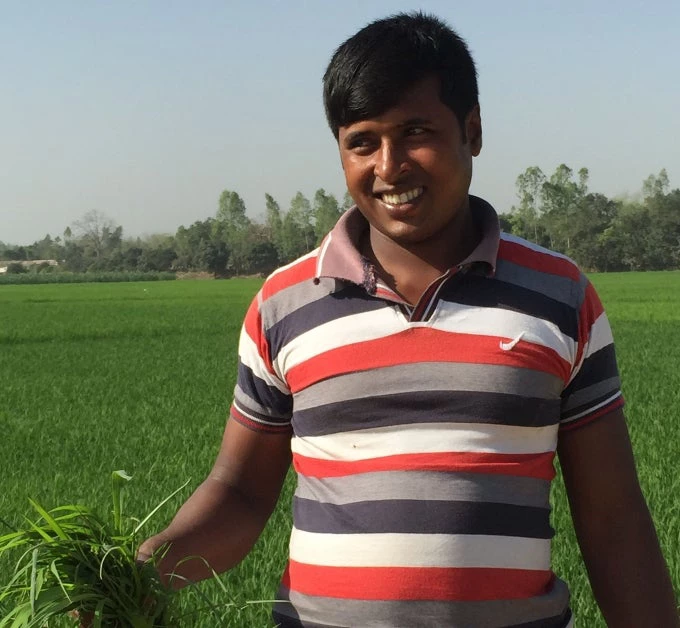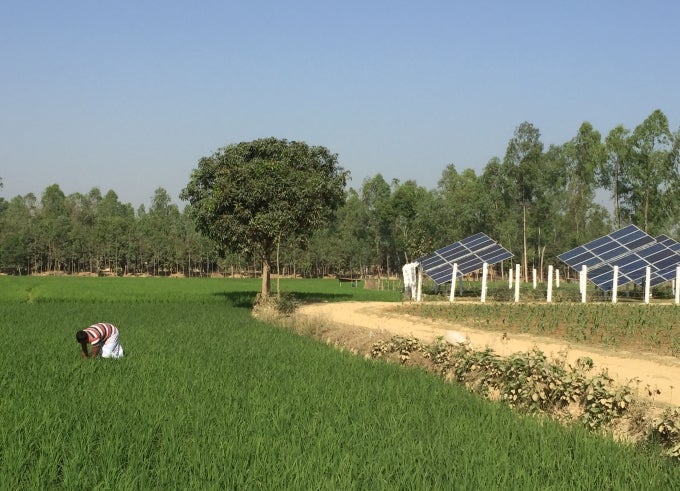
On a recent field trip to northern Bangladesh, the smiles of Habibur, a young man working in a rice field under the scotching sun caught my attention. Habibur, 28, looked content amidst the wide green vista of fields.
I learned that his life had not been easy. His father died when Habibur was around four years old, and the family had no land. His young widowed mother started working as a day laborer to raise her only child. Habibur began working too in his mid-teens. Mother and son struggled, but they managed to save some money. They first bought a cow, and later Habibur leased land for rice cultivation. This is a common practice in rural Bangladesh, where the yield is divided between the farmer and the owner of the land.
Still, life was hard. For rice cultivation, timely irrigation is vital – even missing one day can severely affect crop quality and yield. Habibur and other farmers in his village depended on expensive diesel generators for irrigation. Accessing these was a challenge. Sometimes, Habibur had to spend days in the local bazaar to get the pumps. On top of the rent, he had to pay for the transportation and the diesel fuel. Often the diesel price hiked in the local market, and he had to pay more than the government approved rate. He had to transport the generator to the field and submerge himself in mud to make the diesel pump operational. The farmers had to stay at the field day and night to guard the pump, and to ensure the irrigation.

But, the real benefit goes much deeper. Solar irrigations pumps are improving quality of life for the farmers in Bangladesh . They now have more spare time for other productive purposes. For irrigation, Habibur just notifies the lineman of the solar pumps, and water flows to his entire field. Gone are the days of uncertainty and hard labor to ensure the water supply. Now, he just checks the field twice a day to ensure irrigation, when he visits to collect grass for his cows. With the savings, he has bought more cows, and he has time to care for his cattle. He also has more time to be with his eight-month-old daughter. Meanwhile, the private sponsor of the solar pump in Habibur’s village has identified other bottlenecks to a good crop. The sponsor provides a complete solution, also renting power tillers, as plowing the field is a prerequisite for irrigation.
Following Bangladesh’s success in expanding solar home systems to provide electricity in rural areas, the World Bank is supporting the government’s effort to install 1,250 solar-powered irrigation pumps by 2018. The low-cost technology is well suited for the country’s flat terrain and abundant sunshine.The Rural Electrification and Renewable Energy Development Project II (RERED II) is piloting solar-powered irrigation solutions using a public-private partnership model. The implementing agency, Infrastructure Development Company Limited (IDCOL) channels grant and credit funding to the nongovernment organizations and private investors who install the solar pumps. So far, about 300 pumps are in operation benefitting more than 8,000 farmers. They are more affordable and easier to install than traditional systems. They have no moving parts, function without noise or pollution, and require little maintenance. Even better, the country will be able to reduce 5,000 tons of carbon emissions per year once all the 1250 pumps are in operation.
Today Bangladesh spends around $900 million each year for a million tons of diesel fuel for irrigation. Scaling up solar-powered irrigation will save foreign exchange significantly.
In addition to the World Bank, the Bangladesh Climate Change Resilience Fund (BCCRF), Global Partnership on Output Based Aid (GPOBA), and U.S Agency for International Aid (USAID) have provided financing for the solar irrigation pumps.


Join the Conversation